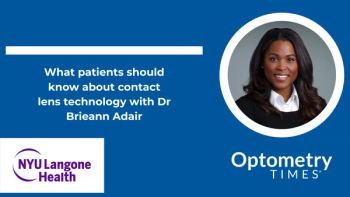
- September digital edition 2021
- Volume 13
- Issue 9
Pupil size matters in presbyopia treatment
Innovative treatment options reflect a shift in focus
The pupil, an important transparent opening of the eye, is responsible for controlling the amount of light that passes through the surface of the lens it exposes. Pupil size during a given moment is affected by several factors and influences how much light reaches the retina.
With age, commonly from 40 to 65 years, a loss of accommodative function is expected, which results in patients requiring more light to read, squinting to see near objects, and holding reading materials farther away. These are some of the first signs of presbyopia.1,2 The importance of pupil size and limitations in human anatomy have inspired the shift in focus to a multitude of procedures, surgeries, and pharmaceutical options to correct presbyopia.
Pupil size matters
Pupil size is influenced by the parasympathetic (constriction) pathway and the sympathetic (dilation) pathway. The pupil is controlled by opposing iris muscles—when the iris sphincter contracts, the pupil constricts; when the iris dilator muscle contracts, the pupil dilates.1
The pupil response at near is part of the 3 eye movements, referred to as the near triad, that usually (but not always) occur together. Pupil constriction in response to light and near fixation decreases the amount of crystalline lens exposed, presumably increasing depth of field and improving visual acuity.1 The pupil response at near is thought to help increase depth of field for near vision across a wider range with a smaller pupil compared with a large pupil.1,2
The near triad also includes1,2:
» Vergence, the inward rotation of the eye when looking at near stimulus and the outward rotation when looking far away
»Accommodation, the steepening curvature of the crystalline lens when looking at a near object and the flattening of the lens to focus on distant objects
It is important to note that other factors can also influence overall pupil size, including luminance, retinal sensitivity, central cognitive processes, alertness, emotional unrest, and refractive error.3 The pupil response involves reflexive and voluntary actions, and the size of a patient’s pupils can affect the levels of chromatic and spherical aberration experienced, which ultimately influences the subjective visual perception.1,2,4
Pupil size is an important consideration when selecting treatment options for presbyopia, including multifocal contact lenses, refractive surgery options, and/or pharmacological options.
Pupil-optimized technology in contact lenses
Other than bifocal or progressive glasses, multifocal contact lenses provide a great nonsurgical option for the treatment of presbyopia. As with most multifocal contact lenses, the optical zone must be centered and aligned with the pupil to work efficiently. The science behind centering and balancing the optic zone over the pupil area is an important factor that can influence best-corrected visual acuity. If a patient’s pupil is too small or too large compared with the optic zone, it can negatively affect the visual potential.
In addition to pupil size constricting with age, note that research has demonstrated that pupil sizes differ because of refractive error.5 Evidence has shown that younger, more myopic patients generally have larger pupils compared with older hyperopic patients who likely have smaller pupils.3,5
Traditional optic zones have typically been “one size fits most” with a standard optic zone size across all refractive powers at distance. Although it is widely understood that pupil size decreases with age, contact lens manufacturers usually offer up to 3 optic zone designs that differ based on the near add power. Until 2021, contact lens multifocal technology has not offered optimization of the multifocal design that accounts for pupil size changes occurring with both age and magnitude of refractive error.3,5
Acuvue Oasys Multifocal (Johnson & Johnson Vision) incorporates a pupil-optimized technology that accounts for variations in natural pupil size.3,5 Instead of 3 pupil size parameters, Acuvue Oasys Multifocal features 183 parameters designed to match different pupil sizes and provide the best balance of vision for that particular refractive error.3,5
Pupil size in refractive surgery
Pupil size can influence vision after cataract and refractive surgery.4,6 When discussing options prior to surgery, it is helpful to guide each patient to a decision while considering details including their activities of daily living, realistic visual goals, and even their pupil size. A larger pupil size can produce greater higher order aberrations and can play an important role in the perceived visual outcome of refractive surgeries because of its effect on postoperative visual symptoms such as glare and halo.6
Postoperatively, some eye care providers recommend off-label usage of brimonidine tartrate ophthalmic solution 0.1% (Alphagan P; Allergan) for its miotic effect. Anecdotally, some have also recommended OTC brimonidine tartrate 0.025% (Lumify; Bausch + Lomb) with an increased usage to decrease pupil size by acting as a selective alpha-2 agonist. The downside is that both these off-label options contain a preservative (Purite and benzalkonium chloride, respectively), likely worsening ocular surface stability when used regularly.
Fortunately, additional nonsurgical options for the treatment of presbyopia are on the horizon. With an additive, synergistic treatment option in the presbyopia market, patients may benefit from a solution to improve near vision with an eye drop that effectively alters the pupil size. As pharmacological options for the treatment of presbyopia emerge, it is important for optometrists and ophthalmologists to embrace this opportunity and address the huge unmet need of presbyopia correction.
Presbyopia-correcting eye drops
Typically, miotic pharmacological drops work by contracting the ciliary muscle, which tightens the trabecular meshwork, allowing an increased outflow of aqueous humor and a decrease in intraocular pressure.4,6 Acting on the pupillary sphincter muscle, miotic eye drops result in miosis, which creates a pinhole effect, allowing improved depth of field without an associated accommodative distance blur.4,6 A pupil constricted too much can have a negative impact on distance vision, night vision, and visual field.
Finding the sweet spot that balances efficacy, safety, and comfort will be the winning combination for patients looking for an alternative to reading glasses. The innovative solutions coming to market must allow patients the freedom to choose when and how they use the alternatives. There can be no compromise for patients with presbyopia—they will not tolerate unwanted adverse events or a drop that stings when making a quality-of-life choice. It will be particularly important for new products in the pipeline to not compromise on safety or comfort because the treatment of presbyopia is a quality-of-life choice and patients will not want to use a product with a low safety profile that is uncomfortable on instillation.
Orasis Pharmaceuticals announced an innovative presbyopia-correcting eye drop that includes a proprietary combination of low-dose pilocarpine (subglaucoma range) and multifaceted vehicle. The primary end point of its phase 2b study demonstrated 3-line improvement in near visual acuity (measured with ETDRS chart) without loss of 1 line or more in best-corrected distance acuity.7 Adverse events reported were mild and temporary, the drug was well tolerated, and no eye redness was observed. The preservative-free formulation ensures no further compromise of the ocular surface. Orasis has initiated phase 3 studies, NEAR-1 and NEAR-2 (NCT04599933 and NCT04599972, respectively).7
Allergan also has a presbyopia-correcting eye drop in the pipeline. An investigational formulation of a once-daily pilocarpine eye drop, AGN-190584, a cholinergic muscarinic receptor agonist, is being studied for the treatment of presbyopia. The new drug application submission to the FDA in 2021 was based on positive results found in 2 different phase 3 trials (GEMINI 1 and GEMINI 2; NCT03804268) that helped to evaluate the safety and efficacy in treating presbyopia.8
Eyenovia’s MicroLine is another eye drop treatment option for near vision impairment secondary to presbyopia, but with its proprietary pilocarpine formulation delivered via its Optejet dispenser.9 The company recently announced the enrollment for phase 3 (VISION-1; NCT04657172), the primary end point is same-day improvement of binocular distance-corrected near visual acuity.9
Other miotics on the horizon include:
»PRX-100 (Presbyopia Therapies), a drop containing aceclidine that induces a pinhole effect with an onset of 30 minutes and a duration of 4 to 5 hours. It causes miosis without the usual accommodative effect, improving near vision without reducing distance vision.10
» Nyxol (Ocuphire Pharma),a preservative-free ophthalmic solution containing 0.75% phentolamine or 1% phentolamine mesylate. This nonselective alpha-adrenergic antagonist inhibits the contraction of smooth muscle of the iris and reduces pupil diameter, resulting in better contrast sensitivity and visual acuity.11
»Brimochol (Visus Therapeutics) is a proprietary formulation of carbachol and brimonidine tartrate that is designed to improve near vision loss associated with presbyopia. With 5 clinical studies evaluating efficacy, Brimochol has shown significant improvement in near visual acuity with no reports in headache or brow ache. Phase 2 trials started in early 2021.12
Conclusion
In summary, pupil size is important to consider when determining the best possible option for presbyopic patients. Pupil size matters, whether considering multifocal contact lenses, premium refractive surgery, or treating presbyopia with an eye drop. Thanks to innovative technology recently launched, ODs have access to pupil-optimized multifocal contact lenses, with options for presbyopia-correcting eye drops on the horizon. The ability to quickly improve near vision with an eye drop in a safe, comfortable, and affordable manner may be a total game changer for patients and practitioners.
References
1. Mathôt S. Pupillometry: psychology, physiology, and function. J Cogn. 2018;1(1):16. doi:10.5334/joc.18
2. Fricke TR, Tahhan N, Resnikoff S, et al. Global prevalence of presbyopia and vision impairment from uncorrected presbyopia: systematic review, meta-analysis, and modelling. Ophthalmology. 2018;125(10):1492-1499. doi:10.1016/j.ophtha.2018.04.013
3. Guillon M, Dumbleton K, Therodoratos P, Gobbe M, Wooley CB, Moody K. The effects of age, refractive status, and luminance on pupil size. Optom Vis Sci. 2016;93(9):1093-1100. doi:10.1097/OPX.0000000000000893
4. Cakmak HB, Cagil N, Simavli H, Duzen B, Simsek S. Refractive error may influence mesopic pupil size. Curr Eye Res. 2010;35(2):130-136. doi:10.3109/02713680903447892
5. Acuvue Oasys Multifocal with Pupil Optimized Design. Acuvue.com. Accessed August 16, 2021. https://www.acuvue.com/contact-lenses/acuvue-oasys-multifocal
6. Hashemian SJ, Soleimani M, Foroutan A, et al. Ocular higher-order aberrations and mesopic pull size in individuals screened for refractive surgery. Int J Ophthalmol. 2012;5(2):222-225. doi:10.3980/j.issn.2222-3959.2012.02.21
7. Katz JA, Karpecki PM, Dorca A, et al. Presbyopia - a review of current treatment options and emerging therapies. Clin Ophthalmol. 2021;15:2167-2178. doi:10.2147/OPTH.S259011
8. Allergan, an AbbVie company, announces positive phase 3 topline results for investigational AGN-190584 for the treatment of presbyopia. News release. AbbVie. October 28, 2020. Accessed August 9, 2021. https://news.abbvie.com/news/press-releases/allergan-an-abbvie-company-announces-positive-phase-3-topline-results-for-investigational-agn-190584-for-treatment-presbyopia.htm
9. Eyenovia announces first patients enrolled in phase 3 study of MicroLine for presbyopia. Press release. December 16, 2020. Accessed August 9, 2021. https://www.businesswire.com/news/home/20201216005342/en/
10. A single-center, double-masked evaluation of the efficacy and safety of PRX-100 in the treatment of early to moderate presbyopia. Clinicaltrials.gov. June 28, 2017. Accessed August 9, 2021. https://clinicaltrials.gov/ct2/show/NCT03201562
11. Ocuphire announces publication of MIRA-1 phase 2b results in optometry and visual science demonstrating reduction of pharmacologically induced mydriasis by Nyxol. Ocuphire. March 5, 2021. Accessed August 9, 2021. https://www.ocuphire.com/news-media/press-releases/detail/329/ocuphire-announces-publication-of-mira-1-phase-2b-results
12. Visus Therapeutics launches and announces clinical development program for novel presbyopia eye drop. September 28, 2020. Accessed August 9, 2021. https://uploads-ssl.webflow.com/5eea6cf86d23885e6fe09eb2/5f71cf04f21701ed849aeef9_Visus%20Release_Launch%20Release_FINAL_09282020.pdf
Articles in this issue
over 4 years ago
CASE REPORT: Self-induced maculopathy by 12-year-old boyover 4 years ago
ODs are ignoring macular degenerationover 4 years ago
Angle closure presentation differsover 4 years ago
Aesthetics and eye care are a natural fitNewsletter
Want more insights like this? Subscribe to Optometry Times and get clinical pearls and practice tips delivered straight to your inbox.













































